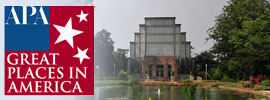American Planning Association Designates Forest Park a Top 10 Great Public Space for 2013
Noted for Design, Amenities, Cultural Institutions, History
October 9, 2013
|
3 min
reading time
This article is 12 years old. It was published on October 9, 2013.

APA singled out Forest Park, the “heart” and “crown jewel of St. Louis,” for its enduring design, myriad cultural institutions, amenities, and 137-year history. The park, which attracts some 13 million visitors annually, completed a $100 million restoration within the last decade. It is the nation’s seventh largest urban park with 1,371 acres, making it 60 percent larger than New York’s Central Park.
"Forest Park is the best urban park in America, and it is getting even better,” said St. Louis Honorable Mayor Francis G. Slay. “That is a result of a unique public-private partnership between the City of St. Louis and Forest Park Forever. We are very pleased and proud, but not surprised by the new designation," Mayor Slay said.
“It’s hard to imagine that just 20 years ago this cultural and historic icon was in an embarrassing state of disrepair,” said APA Chief Executive Officer Paul Farmer, FAICP. “Forest Park’s restoration is the result of a multi-pronged planning effort – involving residents and public-private partnerships – that integrated the park’s natural and man-made features to allow for a cohesive and complete visitor experience.”
It was Forest Park’s selection as the site of the 1904 Louisiana Purchase Exposition that thrust it onto the world stage. The park’s redesign by George Kessler, a prominent landscape architect, resulted in dramatic changes, including the transformation of wetlands into five connected lakes. In addition to the Saint Louis Art Museum, four other institutions – a zoo, science center, history museum and the nation’s largest outdoor amphitheater dedicated to musical theater – call Forest Park home.
Decades of deferred maintenance took its toll on the park and by the 1970s its infrastructure was crumbling. A 1993 master plan, developed by the nonprofit Forest Park Forever and the City of St Louis, led to creation of a public-private partnership, which raised more than $100 million to restore buildings, landscapes, habitats and roadways.
“We are thrilled that APA has shined its national spotlight on Forest Park,” said Lesley Hoffarth, President and Executive Director of Forest Park Forever. “Our staff, members, donors and partners have worked extraordinarily hard in recent decades to restore this essential community treasure for our millions of visitors. While our important work continues — every day, across every acre — we are proud to take this moment to celebrate this meaningful designation.”
APA’s Great Public Spaces, Great Neighborhoods, and Great Streets feature unique and authentic characteristics that have evolved from years of thoughtful and deliberate planning by residents, community leaders and planners. The 2013 Great Places have many things Americans say are important to their “ideal community” including locally owned businesses, transit, neighborhood parks, and sidewalks. They illustrate how the foresight of planning fosters communities of lasting value.
The nine other APA 2013 Great Public Spaces are: Tony Knowles Coastal Trail, Anchorage, AK; Grand Park, Los Angeles, CA; The Broadwalk in Florida’s Hollywood, Hollywood, FL; Norman B. Leventhal Park at Post Office Square, Boston, MA; Mount Auburn Cemetery, Cambridge, MA; Essex County Branch Brook Park, Newark, NJ; Grand Central Terminal, New York City, NY; Walnut Street Pedestrian Bridge, Chattanooga, TN; and Esther Short Park, Vancouver, WA.
For more information about these public spaces, as well as APA’s top 10 Great Streets and top 10 Neighborhoods for 2013 and previous years, visit www.planning.org/greatplaces. For more about National Community Planning Month taking place throughout October visit www.planning.org/ncpm.
The American Planning Association is an independent, not-for-profit educational organization that provides leadership in the development of vital communities. APA and its professional institute, the American Institute of Certified Planners, are dedicated to advancing the art, science and profession of good planning -- physical, economic and social -- so as to create communities that offer better choices for where and how people work and live. Members of APA help create communities of lasting value and encourage civic leaders, business interests and citizens to play a meaningful role in creating communities that enrich people's lives. APA has offices in Washington, D.C., and Chicago, Ill. For more information, visit www.planning.org.
-
Department:
Department of Parks
Recreation
and Forestry
-
Topic:
Parks and Gardens
Related Stories
Feedback is anonymous.